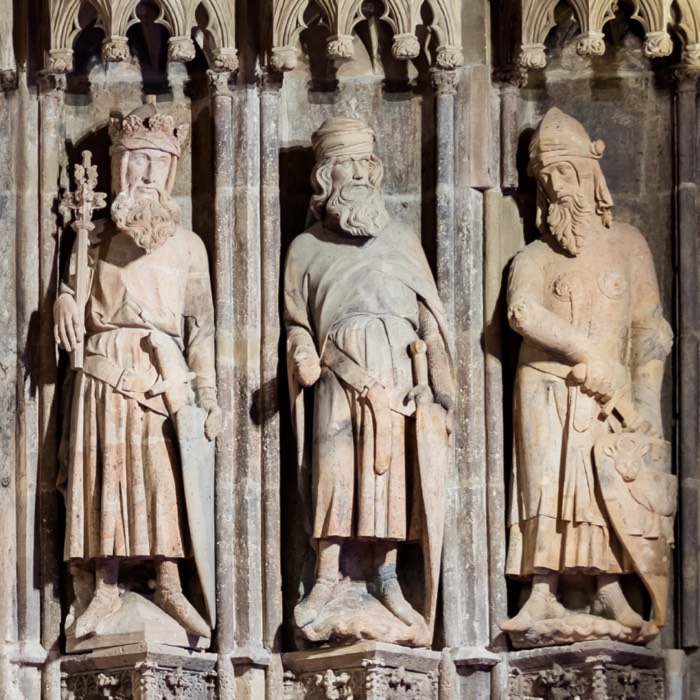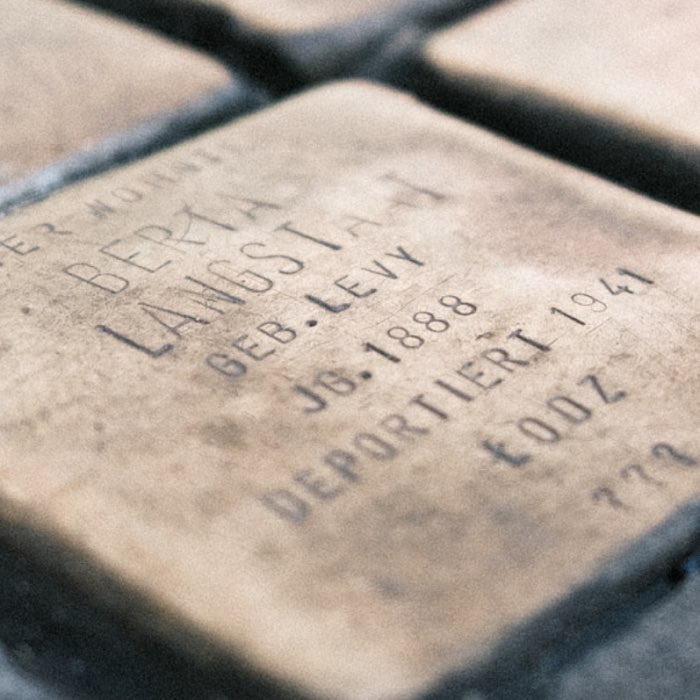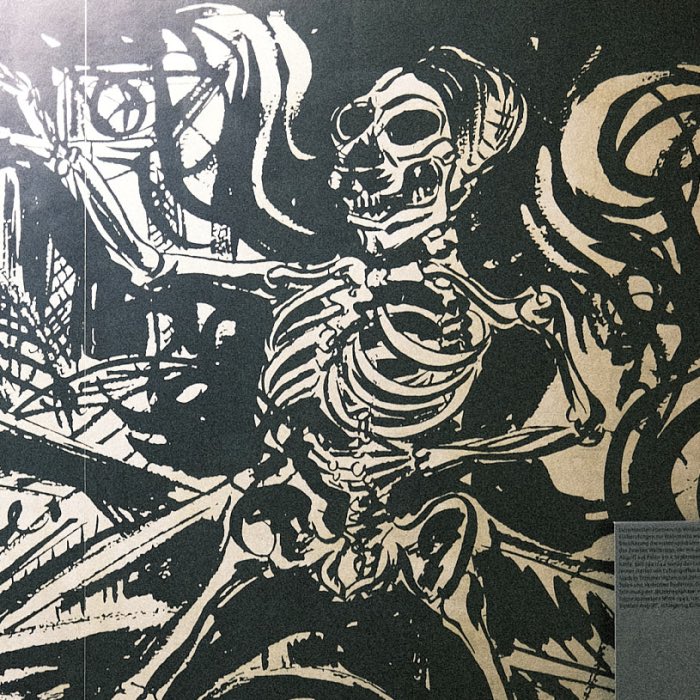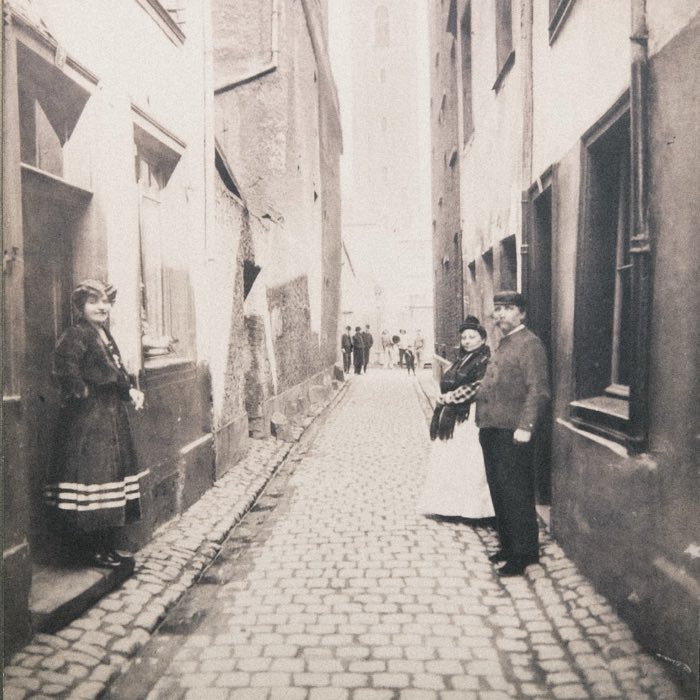NS DOK El-De Haus: Retracing the steps of Nazi history in Cologne
I recently visited the El-De Haus in Cologne, a former center of the Gestapo and now the NS Documentation Centre of Cologne, which left a profound impression on me. The house is not like other museums; it is a storyteller of a dark chapter in Cologne’s history and a stark reminder of the horrors that totalitarian regimes like the Nazis can inflict. What I liked most is that the documentation center focuses on the story of victims and the resistance to the Nazi regime, giving them much more space than the perpetrators. Here is a summary of the exhibition, coupled with my personal reflections. All photographs presented were taken by me, and the accompanying descriptions are primarily based on information provided by the documentation center.
 Exhibition area of the NS Documentation Centre in the El-De Haus.
Exhibition area of the NS Documentation Centre in the El-De Haus.
Cologne under the Nazi dictatorship
Before the regime change, Cologne was a bustling hub of cultural diversity and liberal thought. Known for its vibrant arts scene and the celebrated Cologne Carnival, the city epitomized openness and creativity. However, this dynamic landscape underwent a drastic transformation under the Nazi regime.
As the Nazis seized power, Cologne’s cityscape and culture shifted dramatically. Nazi architectural principles began to dominate, with imposing structures emerging to reflect the regime’s ideology. Public life, once marked by a rich tapestry of cultural expression, was now under the shadow of censorship and propaganda. The once-lively arts and cultural scene was suppressed, replaced by state-sanctioned events designed to bolster the Nazi ideology. The Cologne Carnival, a symbol of the city’s identity, was not spared, as it too was co-opted and ‘browned’ to align with Nazi propaganda. For example, traditional carnival parades and festivities, once a celebration of local culture and humor, willingly or unwillingly transformed into events promoting Nazi racial ideology. This appropriation demonstrated the regime’s intent to infiltrate and reshape all aspects of cultural life.
 Office of the Cologne NSDAP, Hohenzollernring 81, 1928.
Office of the Cologne NSDAP, Hohenzollernring 81, 1928.
The Jewish community in Cologne, once integral to the city’s vibrant cultural and economic life, faced devastating persecution. Systematic disenfranchisement, dispossession, and eventual deportation marked the harrowing experience of the Jews in Cologne. The once-thriving Jewish quarters stood as a haunting reminder of the community that had been torn apart by the Holocaust.
 Meeting of leading National Socialists of the Rhineland branch in Cologne, 1928.
Meeting of leading National Socialists of the Rhineland branch in Cologne, 1928.
Cologne was also a site of brutal atrocities. The city saw the establishment of forced labor camps and detention centers. These sites were grim embodiments of the regime’s cruelty and inhumanity, where countless individuals were subjected to extreme hardship and degradation. For instance, the Messelager Köln, a notorious forced labor camp located at the Cologne Trade Fair in Deutz, was a place of severe mistreatment and suffering for many prisoners. Additionally, during the war, companies like Ford in Cologne utilized forced labor, with workers living under appalling conditions, deprived of basic rights and subjected to harsh treatment. These examples illustrate the widespread use of forced labor in Cologne and the inhumane conditions under which people were forced to work, reflecting the broader cruelty of the Nazi regime in urban centers.
 Cologne during the Nazi regime.
Cologne during the Nazi regime.
At the heart of this dark chapter was the El-De Haus, the Gestapo’s headquarters in Cologne. It became a symbol of terror within the city – a place where detainees were held, interrogated, and tortured. The El-De Haus played a pivotal role in the regime’s machinery of repression, serving as a stark reminder of the inhumanity and brutality that pervaded the city during the Nazi dictatorship.
 Entrance to the Protestant parish hall in Cologne-Bayenthal (Martin Luther House), inaugurated in 1934; relief on the left: Martin Luther; relief on the right: SA man. In 1932, the National Socialist-oriented faith movement German Christians emerged within the Protestant Church. Supported by the new regime’s policy of equalization, the German Christians in Cologne achieved considerable success in 1933. Throughout the entire Nazi era, they exercised a decisive influence in most Cologne parishes and church bodies.
Entrance to the Protestant parish hall in Cologne-Bayenthal (Martin Luther House), inaugurated in 1934; relief on the left: Martin Luther; relief on the right: SA man. In 1932, the National Socialist-oriented faith movement German Christians emerged within the Protestant Church. Supported by the new regime’s policy of equalization, the German Christians in Cologne achieved considerable success in 1933. Throughout the entire Nazi era, they exercised a decisive influence in most Cologne parishes and church bodies.
The El-De Haus
The El-De Haus, originally built for business purposes, became the headquarters of the Gestapo (“Geheime Staatspolizei” or Secret State Police) in Cologne. Its transformation from a commercial building to a center of Nazi terror is emblematic of the broader changes in Germany at the time. The building’s architecture, which now seems unassuming, hides a past filled with secrets and terror, making it a potent symbol of the city’s suffering and resilience during the Nazi era.
 El-De Haus around 1936. The headquarters of the Secret State Police (Gestapo) for the government district of Cologne was based in this building from December 1935 to March 1945. Investigations, interrogations, torture and murder took place here.
El-De Haus around 1936. The headquarters of the Secret State Police (Gestapo) for the government district of Cologne was based in this building from December 1935 to March 1945. Investigations, interrogations, torture and murder took place here.
The Gestapo’s use of the El-De Haus is a grim chapter in its history. The building was a site of terror: a place for interrogations, imprisonment, and torture. The cellars, where many were held and abused, stand as a stark reminder of the cruelty inflicted upon those who opposed the Nazi regime or were deemed undesirable.
 The Appellhofplatz court building, directly opposite El-De Haus, was the seat of the district court, the regional court and also the special courts. Around 600 trials for ‘racial defilement’ were held here. In 1979, the trial of Kurt Lischka, who was head of the Cologne Gestapo in the EL-DE building in 1940, took place there.
The Appellhofplatz court building, directly opposite El-De Haus, was the seat of the district court, the regional court and also the special courts. Around 600 trials for ‘racial defilement’ were held here. In 1979, the trial of Kurt Lischka, who was head of the Cologne Gestapo in the EL-DE building in 1940, took place there.
 Another photo that gives a further impression of how central and embedded the El-De Haus was and is in the city.
Another photo that gives a further impression of how central and embedded the El-De Haus was and is in the city.
However, its story doesn’t end with the fall of the Third Reich. Post-war, the building faced the possibility of being forgotten or repurposed, erasing its dark history. It was the dedication and perseverance of committed citizens of Cologne that led to its preservation and transformation into a NS Documentation Centre. These engaged individuals recognized the building’s significance as a testament to the past, ensuring it would serve as a perpetual reminder and educational site for the atrocities committed by the Gestapo. This act of civic responsibility helped to repurpose a site of terror into one of remembrance and learning, making the El-De Haus a powerful symbol of Cologne’s resilience and commitment to confronting its history.
 On March 18, 1987, Cologne citizens staged a protest in front of and inside the EL-DE House demanding the establishment of a Nazi documentation center. They even managed to reach the city’s head of legal affairs, Dr. Simon.
On March 18, 1987, Cologne citizens staged a protest in front of and inside the EL-DE House demanding the establishment of a Nazi documentation center. They even managed to reach the city’s head of legal affairs, Dr. Simon.
 Protest poster for the establishment of an NS documentation site in the EL-DE House.
Protest poster for the establishment of an NS documentation site in the EL-DE House.
NS Documentation sites
NS documentation sites like the El-De Haus play a vital role in Germany’s efforts to confront its Nazi past. These sites serve as educational resources, providing historical context and personal stories to illustrate the extent of Nazi crimes. They help in understanding the societal structures that allowed such atrocities to occur and the importance of vigilance in preserving democratic values.
Cologne, scarred by its past, is home to several other documentation sites. Each site offers a different perspective on the Nazi era, from the roles of ordinary citizens and the church to the experiences of various victim groups. Collectively, these sites paint a comprehensive picture of the city’s struggle and endurance under Nazi rule.
 Today’s exhibition area of the NS Documentation Centre in the EL-DE House.
Today’s exhibition area of the NS Documentation Centre in the EL-DE House.
 Today’s exhibition area of the NS Documentation Centre in the EL-DE House.
Today’s exhibition area of the NS Documentation Centre in the EL-DE House.
 The library of the El-De Haus.
The library of the El-De Haus.
Exhibitions
The exhibition at the El-De Haus offers a deep and immersive exploration of Cologne’s experience under Nazi rule. Spanning multiple floors, it presents a comprehensive narrative that covers the rise of the Nazi regime, its impact on the city and its people, and the acts of resistance that emerged in defiance. The exhibits focus on personal stories, victim groups, and the city’s diverse resistance movements, providing a human-centered perspective on history. Artifacts, photographs, and detailed documentation are complemented by the preserved Gestapo cells, which serve as stark reminders of the terror inflicted by the regime.
The exhibition covers a wide array of topics and victim groups, including Jewish persecution, forced labor, youth resistance, and more. However, the richness and depth of these individual stories were too much to be included in this article. To give them the attention they deserve, I have written follow-up articles focusing on each topic in detail:
- Fate of the Jews in Cologne under Nazi rule
- Forgotten Victims of the Nazi regime: ‘Social Outcasts’
- Forgotten victims of the Nazi regime: Disabled individuals
- Forgotten victims of the Nazi regime: Roma and Sinti
- Persecution of homosexuals under the Nazi regime
- Youth resistance groups in Cologne against the Nazi regime
- Acts of resistance in Cologne against the Nazi regime
- Consequences of the war for the people of Cologne
The Gestapo cells in the cellar: Silent witnesses to oppression, brutality and torture
The Gestapo cellars in the El-De Haus, now meticulously documented, reveal the extent of the horrors that took place within. They serve as a physical and historical record of the inhumanity that occurred, acting as a powerful educational tool and a place for reflection and mourning.
 The Gestapo prison in the cellar.
The Gestapo prison in the cellar.
Adventurous escape
Askold Kurow managed to escape from the Gestapo prison in an adventurous way. He was deployed in the underground cellar to transport files when the Gestapo officer on duty was summoned to the prison one floor above by the ringing of the telephone. Askold Kurow was able to escape because the door to the boiler room was unlocked. The windows in this area were not barred, as this room was used to deliver coal. He managed to escape and flee to the Bergisches Land.
 The boiler room through which Askold Kurow managed to escape.
The boiler room through which Askold Kurow managed to escape.
Conclusion
The El-De Haus, through its transformation into a documentation center, stands as a beacon of memory and education. It confronts us with the realities of our past, emphasizing the importance of remembering and understanding history. This understanding is crucial to ensuring that the horrors of the Nazi regime are never repeated and that future generations recognize the value of tolerance, human rights, and democracy.
The detailed exhibitions, from personal stories to the depiction of daily life under Nazi rule, provide a comprehensive and engaging journey through time. It’s a stark reminder of how a city’s vibrant culture and diverse community can be systematically dismantled by totalitarian ideologies. The El-De Haus plays a vital role in keeping these memories alive, serving as a custodian of history that challenges us to reflect on the consequences of hate and the importance of standing against injustice.
I was actually suprised by my visit to the El-De Haus. I had expected a more traditional museum experience, but the El-De Haus is more than just that. It’s a powerful reminder of our collective responsibility to remember the past and learn from it. It’s a testament to Cologne’s resilience and an educational resource that imparts crucial lessons about the dangers of extremism and the necessity of vigilance in safeguarding freedoms. The lessons learned here are not just historical footnotes but guiding principles for a more just and inclusive future.
At the end, two final images from the exhbition: One portrays the Nazis’ grand vision for Cologne in 1939, while the other reveals where the Nazi ideology ultimately led: the complete destruction of the city and the suffering of its people.
 “Das Zukunftsbild Kölns aus der Vogelschau” (The future image of Cologne from a bird’s eye view) – The Nazis’ vision for the future of Cologne. From: “Geschenk der Hansestadt Köln zum fünfzigsten Geburtstage des Führers”, 1939.
“Das Zukunftsbild Kölns aus der Vogelschau” (The future image of Cologne from a bird’s eye view) – The Nazis’ vision for the future of Cologne. From: “Geschenk der Hansestadt Köln zum fünfzigsten Geburtstage des Führers”, 1939.
 Neumarkt, Cologne, April 19, 1945.
Neumarkt, Cologne, April 19, 1945.
References and further reading
- Website of the NS Documentation Center El-De Hausꜛ
- NS-Dokumentationszentrum der Stadt Köln, Köln im Nationalsozialismus: Ein Kurzführer durch das ELDE Haus (NS-Dokumentation), 2010, Emons Verlag, ISBN: 978-3897052093
- Werner Jung, Bilder einer Stadt im Nationalsozialismus: Köln 1933-1945, 2016, Emons Verlag, ISBN: 9783740800147
- Horst Matzerath, Geschichte der Stadt Köln, Bd. 12: Köln in der Zeit des Nationalsozialismus 1933-1945, 2009, Greven, ISBN: 978-3774304291
- Hans Peter Richter, Damals war es Friedrich: Roman, 1979, dtv Verlagsgesellschaft mbH & Co. KG, ISBN: 978-3423078009.
- jugend1918-1945.deꜛ
- Interactive website exploring Jewish live in Cologneꜛ (a web-app by LVR Jüdisches Museum im Archäologischen Quartier Köln)



























comments